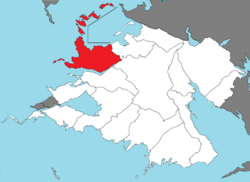Jade
Jade | |
|---|---|
 Jade located in Zamastan | |
| Country | Zamastan |
| Capital | White Rock |
| Largest city | Jade Harbor |
| Province | October 28, 1804 |
| Government | |
| • Governor | Fallon Chapman (GLP) |
| Population | |
| • Total | 60,163,000 |
Jade is a province of Zamastan, bordered to the east by Zian, to the south by Redeemer’s Land and Pahl, and with an extensive coastline on the Olympic Ocean. It consists of a mainland region and a archipelago of over 2,000 islands encircling the Horseshoe Bay. Its capital is White Rock and its largest city is Jade Harbor. It is the third-most populated province in the country with 60.1 million people, with major cities with populations above one million including Jurrania, Point Tarin, Alberni, Percilius, Terrabone, Birken, Camp Island, and Huntington Park. The Tarin Peninsula metropolitan region alone is home to nearly 30 million people. It has a varied economy, but has made significant strides in the technological sector.
Historically, it has been the longest inhabited area in Western Euronia, being home to the earliest tribes of the Catica First Nations. Caspiaan settlements in the 1300s, followed by Adulan exploration in the 1600s led to the region becoming a colony of the Quetanan and Skithan empires. Following the War of Independence and the establishment of the Republic of Zamastan, Jade was the first province alongside Zian to form the country. Industrialization led to dramatic social and demographic changes, including large-scale immigration into Jade, and a worldwide economic boom. The relocation of many indigenous peoples by President George O'Galvin in 1832 eventually resulted in a national reckoning regarding civil rights in Zamastan, and the province became the epicenter for indigenous, same-sex, and immigrant rights movements in the 1960s-70s.
The province has made noteworthy contributions in the fields of communication, information, innovation, environmentalism, economics, and politics. It is the home one of the oldest and largest film industries in the world, which has had a profound effect on global entertainment. The Jade Harbor Area and Tarin Peninsula Region are widely seen as centers of the global technology and film industries, respectively. Jade province's economy is very diverse: 58% of it is based on finance, government, real estate services, technology, and professional, scientific, and technical business services. Although it accounts for only 1.5% of the state's economy, Jade's agriculture industry has the second highest output of any province after Pahl. Jade's ports and harbors handle about a third of all national imports, most originating in Olympic maritime trade to and from northern Adula and eastern Nortua.
The province's extremely diverse geography ranges from the coasts to mountains to rainforests and deserts. The Rembal Valley, a major agricultural area, dominates the province's center. Although Jade is well known for its warm climate and monsoon seasonal weather, the large size of the Jade results in climates that vary from moist temperate rainforest in the north to arid desert in the interior, as well as snowy alpine in the mountains. All these factors lead to an enormous demand for water. Over time, droughts and wildfires have been increasing in frequency and severity due to climate change and overextraction, becoming less seasonal and more year-round, further straining Jade's water security and having an impact on Jade's business and industry in addition to agriculture.
Etymology
Geography
History
Government
The Government of Jade embodies the governmental structure of the Province of Jade as established by the Jade Provincial Constitution. It is composed of three branches: executive, legislative, and judicial. The governor is the province's chief executive and is assisted by the lieutenant governor. Both are elected on the same ticket. Additional elected officers include the attorney general and the comptroller. The secretary of state, formerly an elected officer, is currently appointed by the governor.
The Jade Provincial Legislature is bicameral and consists of the Provincial Senate and the Provincial Assembly. The provincial assembly consists of 150 members, while the provincial senate varies in its number of members. The legislature is empowered to make laws, subject to the governor's power to veto a bill. However, the veto may be overridden by the legislature if there is a two-thirds majority in favor of overriding in each house. The highest court of appeal in the Unified Court System is the Court of Appeals whereas the primary felony trial court is the District Court (or the Supreme Court). The Provincial Supreme Court also acts as the intermediate appellate court for many cases, and the local courts handle a variety of other matters including small claims, traffic ticket cases, and local zoning matters, and are the starting point for all criminal cases.
The province is divided into districts, cities, towns, and villages, all of which are municipal corporations with respect to their own governments, as well as various corporate entities that serve single purposes that are also local governments, such as school districts, fire districts, and provincial public-benefit corporations, frequently known as authorities or development corporations. Each municipal corporation is granted varying home rule powers as provided by the Jade Provincial Constitution.
Federal representation
Jade is represented by 8 senators and 51 congressional districts in Congressional Hall.


